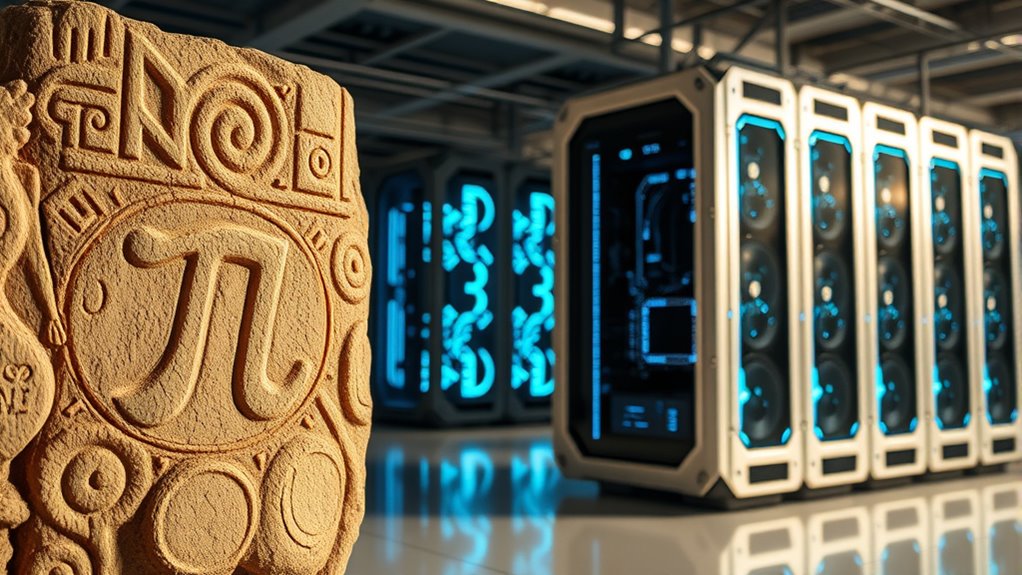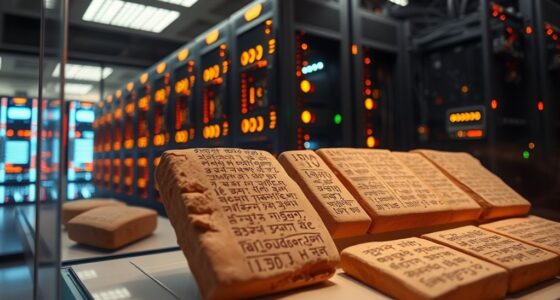The story of Pi shows how humans have sought to understand this constant ratio of a circle’s circumference to its diameter for thousands of years. From ancient civilizations like the Egyptians and Babylonians to Greek mathematicians such as Archimedes, each era improved approximations. As mathematicians in India and China refined techniques, Pi’s accuracy increased. Today, supercomputers push its value to incredible precision, revealing humanity’s endless curiosity—if you continue, you’ll learn even more about this fascinating mathematical journey.
Key Takeaways
- Ancient civilizations like Egyptians and Babylonians made early approximations of Pi using basic geometric methods.
- Greek mathematicians, notably Archimedes, developed systematic techniques to refine Pi’s value through polygons.
- Asian mathematicians, including Liu Hui and Madhava, advanced Pi calculations with infinite series and sophisticated geometry.
- The advent of calculus in the 17th century enabled more precise Pi computations and laid groundwork for modern algorithms.
- Today, supercomputers have calculated Pi to trillions of digits, continuing humanity’s quest for mathematical precision.

The story of Pi is a fascinating journey through mathematics, history, and human curiosity. As you explore its origins, you begin to see how ancient civilizations understood the concept of a circle’s ratio long before the modern era. The roots of Pi are deeply embedded in the geometry history of early societies. Thousands of years ago, ancient Egyptians and Babylonians recognized that the ratio of a circle’s circumference to its diameter was a constant, even if they didn’t have a precise value for Pi itself. The Egyptians, for instance, used rough approximations in their architectural projects, like the construction of pyramids and temples, where understanding circles was essential. Meanwhile, the Babylonians approached the problem with their own methods, calculating Pi as approximately 3.125, based on their geometric measurements and calculations. These early efforts laid the groundwork for a mathematical exploration that would span centuries and civilizations.
As you trace the development of geometry history, you notice that the Greeks played a pivotal role. Mathematicians like Euclid formalized geometric principles in his influential work, “Elements,” around 300 BCE. Euclid’s systematic approach to geometry helped solidify the understanding of circles and their properties, bringing Pi into clearer focus. Later, Archimedes of Syracuse made significant strides by developing an ingenious method of inscribing and circumscribing polygons around circles, gradually tightening the bounds on Pi’s value. His work marked a turning point in the geometry history of Pi, as he used a method akin to modern calculus to approximate Pi to an accuracy that was unprecedented at the time. The Greek contributions to geometry history not only advanced the understanding of Pi but also established methods of mathematical proof and reasoning that still influence mathematics today.
Moving into the Middle Ages and Renaissance, mathematicians in India, China, and the Islamic world built upon this foundation. They refined approximations of Pi, often using their own geometric techniques. For example, the Chinese mathematician Liu Hui calculated Pi as approximately 3.14159, and Indian mathematician Madhava used infinite series to approximate Pi more precisely. These developments highlight how the geometry history of Pi evolved through increased sophistication in mathematical methods and geometric understanding. It wasn’t until the advent of calculus in the 17th century that the pursuit of Pi became more exact than ever before, leading to the modern computational techniques we use today. Your journey through the geometry history of Pi reveals a story of human ingenuity, curiosity, and relentless pursuit of mathematical truth across ages.
Frequently Asked Questions
How Did Ancient Civilizations First Discover the Concept of Pi?
You see, ancient civilizations discovered the concept of pi through ancient geometry, observing that the ratio of a circle’s circumference to its diameter remained constant. They used simple tools like ropes and sticks to measure circles, recognizing its cultural significance in architecture and astronomy. Over time, these early observations laid the foundation for understanding pi, which became essential in their mathematical and cultural advancements.
What Are the Most Significant Mathematical Breakthroughs Related to Pi?
Imagine revealing a hidden treasure inside a circle, revealing its secrets through mathematical breakthroughs. You discover that pi, a fundamental circle constant, is an irrational number, meaning it can’t be precisely expressed as a fraction. Key advances include the development of infinite series like the Leibniz series, which approximate pi more accurately. These milestones deepen your understanding of circle constants and shape the foundation of modern mathematics.
How Do Supercomputers Calculate Pi to Trillions of Digits?
Supercomputers calculate pi to trillions of digits using advanced algorithms like the Gauss-Legendre and Chudnovsky algorithms, which optimize convergence speed. They leverage quantum algorithms to handle immense computational complexity, reducing processing time markedly. You can imagine these calculations as breaking down the problem into smaller parts, then solving them simultaneously with powerful hardware. This combination enables precise, rapid computation of pi’s vast decimal expansion, pushing the boundaries of mathematical and computational capabilities.
What Are the Practical Applications of Pi in Modern Technology?
Imagine you’re designing a new bridge, and you need precise circle measurements for arches. Pi plays an essential role in engineering calculations, ensuring structures are safe and accurate. In modern technology, pi helps in fields like aerospace, where it’s used for calculating orbits and designing curved surfaces. Its applications extend from everyday engineering to advanced simulations, making pi indispensable for ensuring precision and reliability in numerous technological innovations.
Are There Any Ongoing Efforts to Find More Digits of Pi?
Yes, you’re right to wonder. Researchers are actively using advanced computational algorithms to discover more digits of pi, often aiming to test the limits of supercomputers. They analyze digit distribution patterns to understand randomness. While these efforts don’t have direct practical uses, they help improve algorithms and computational power, pushing technology forward. So, ongoing projects continue pushing the boundary of pi’s digits, driven by curiosity and technological progress.
Conclusion
As you reach the end of this journey through pi’s history, you realize its true mystery isn’t just in its endless digits. It’s in how it challenges what you think you know, pushing boundaries from ancient civilizations to supercomputers. But the story isn’t over yet. With every new discovery, pi continues to surprise, leaving you wondering—what secrets does the infinite number still hold? And how much more will we uncover? The next chapter waits.









